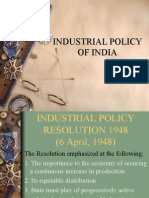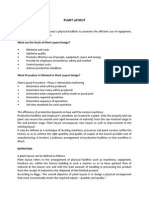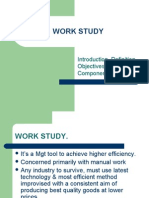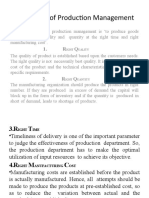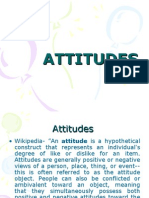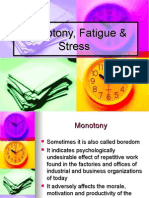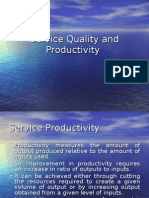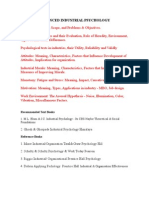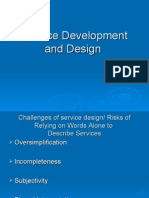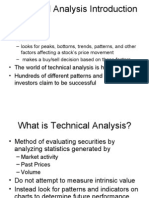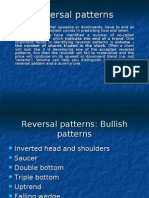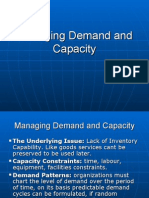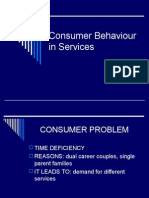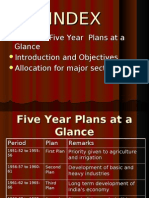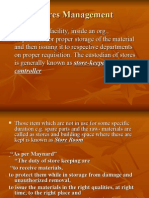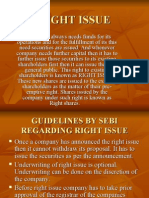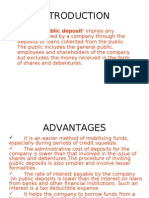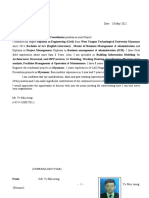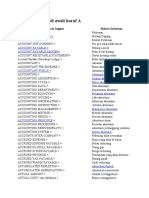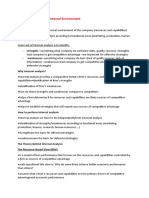86%(7)86% found this document useful (7 votes)
6K viewsFacility Location & Layout
Facility Location & Layout
Uploaded by
Heavy GunnerThe document discusses factors that influence the selection of facility locations and plant layouts. Key considerations for location include raw material availability, proximity to markets, labor, transportation and local regulations. Plant layout aims to arrange equipment and workflow to minimize costs through efficient material flow. The main types of layouts are product layout with continuous flow, functional layout which groups similar machines, and stationary layout where materials do not move. Overall, location and layout significantly impact operating costs and productivity.
Copyright:
Attribution Non-Commercial (BY-NC)
Available Formats
Download as PPT, PDF, TXT or read online from Scribd
Facility Location & Layout
Facility Location & Layout
Uploaded by
Heavy Gunner86%(7)86% found this document useful (7 votes)
6K views22 pagesThe document discusses factors that influence the selection of facility locations and plant layouts. Key considerations for location include raw material availability, proximity to markets, labor, transportation and local regulations. Plant layout aims to arrange equipment and workflow to minimize costs through efficient material flow. The main types of layouts are product layout with continuous flow, functional layout which groups similar machines, and stationary layout where materials do not move. Overall, location and layout significantly impact operating costs and productivity.
Original Title
2. Facility Location & Layout
Copyright
© Attribution Non-Commercial (BY-NC)
Available Formats
PPT, PDF, TXT or read online from Scribd
Share this document
Did you find this document useful?
Is this content inappropriate?
The document discusses factors that influence the selection of facility locations and plant layouts. Key considerations for location include raw material availability, proximity to markets, labor, transportation and local regulations. Plant layout aims to arrange equipment and workflow to minimize costs through efficient material flow. The main types of layouts are product layout with continuous flow, functional layout which groups similar machines, and stationary layout where materials do not move. Overall, location and layout significantly impact operating costs and productivity.
Copyright:
Attribution Non-Commercial (BY-NC)
Available Formats
Download as PPT, PDF, TXT or read online from Scribd
Download as ppt, pdf, or txt
86%(7)86% found this document useful (7 votes)
6K views22 pagesFacility Location & Layout
Facility Location & Layout
Uploaded by
Heavy GunnerThe document discusses factors that influence the selection of facility locations and plant layouts. Key considerations for location include raw material availability, proximity to markets, labor, transportation and local regulations. Plant layout aims to arrange equipment and workflow to minimize costs through efficient material flow. The main types of layouts are product layout with continuous flow, functional layout which groups similar machines, and stationary layout where materials do not move. Overall, location and layout significantly impact operating costs and productivity.
Copyright:
Attribution Non-Commercial (BY-NC)
Available Formats
Download as PPT, PDF, TXT or read online from Scribd
Download as ppt, pdf, or txt
You are on page 1of 22
Introduction
The performance of an enterprise is
considerably affected by its location.
The degree of significance for the selection of
location for any enterprise mainly depends on
its size and nature. Sometimes the nature of
the product itself suggests some suitable
location like a small scale industry mainly
selects the site where in accordance with its
capacity the local mkt. for the product is
available.
Importance of Facility location
Location of plant partially determines
operating and capital costs. It determines the
nature of invt. Costs to be incurred and also
the level of many operating costs.
Each prospective location implies a new
allocation of capacity to respective mkt. area
Govt. sometimes play an imp. Role in the
choice of the location keeping in view the
national benefits.
Factors responsible for location
choices
Availability of raw material:-
Nearness to the potential mkt.:- mgt. can keep close
touch with the changes in mkt. environment and
formulate its prod’n policies accordingly
Location shd. Be near to the source of operating
requirements;- like in some industries continuous
and adequate supply of power is of great significance
e.g.. Nylon fibre plant.
Supply of labour:-
Transport and communication facilities:-
Integration with other group of companies:-
Suitability of land and climate:- like damp climate is
favorable for textile and cotton industries.
Availability of housing, other amenities and services.
9. Local building and planning regulations:-
local regulations and byelaws.
10. Safety reqd’s:- industries like nuclear power
stations or chemical process likely to pollute
the atmosphere shd. Be located in remote
areas.
Measures for the selection of
location
1. Involving quantitative factors:-
(b) Comparative cost analysis
(c) Break-even and dimensional analysis.
2. Comparison of qualitative factors.
Plant Layout
“Layout identically involves the allocation of
space and the arrangement of equipment in
such a manner that overall operating costs are
minimized”.
Plant layout is an effort to arrange machines and
equipment, and other services within a
predesigned building-ensuring steady, smooth
and economical flow of material.
Layout begins with plant location and
continuous through three further levels
namely:
3. The layout of deptt. within the site.
4. Layout of items within the deptt.
5. Layout of individual work places.
Why layout problems exists
Enlargement or contraction of existing deptt.
Movement of a deptt. due to change in the
design of product
Addition of some new deptt. eg.
Computerization
Replacement or addition of some new
facility/machinery
Stages of plant layout
1. Product demand
2. Prod’n reqd.s.
3. Components and parts analysis
4. Work methods and measurements
5. Machine reqd’s
6. Handling and movement reqd’s.
7. Space reqd.s.
Objectives of layout
1. Economies in materials, facilitate mfg process and
handling of semi-finished goods.
2. Proper and efficient utilization of available floor
space .
3. To ensure that work proceeds from one point to
another point inside the plant w/o any delay
4. Provision of better supervision and ctrl of
operations.
5. Careful planning to avoid frequent changes in layout
which may result in undue increase in cost of prod’n
6. To provide adequate safety to the workers from
accidents
7. To meet the quality and capacity reqd’s in the
most economical manner.
8. Provision of medical facilities and cafetria at
suitable and convenient places
9. To provide efficient material handling system.
10. To suggest improvements in prod’n process
and work methods.
Advantages of a good layout
To the Worker
2. Lesser number of operations and material handling.
3. Reduction in length of hauls and motions b/w
operations minimizes prod’n time as well as the
activities of workers .
4. More Labour productivity i.e. more output per man-
hour i.e. low work in progress and high turnover.
5. More safety and security to workers from accidents.
6. Better working conditions resulting improved
efficiency.
In Manufacturing Costs
Maintenance and replacement costs are
reduced.
Loss due to waste and spoilage is minised.
Improved quality of product with reduction in
handling i.e. movement, time and cost.
Better cost control.
In prod’n ctrl and supervision
1. Provides more space for prod’n operations.
2. Ctrl and supervision operations are provided
at appropriate points
3. Better and convenient storage facilities.
4. Efficient arrangement for receipt, tpt’n and
delivery of raw material and finished goods.
5. Results in less inspection activity.
6. Cost and effort in the supervision of prd’n
process are minimized.
A good layout leads to efficient and optimum
use of machines labour and capital by
minimizing per unit prod’n time and
maintaining a proper balance b/w various
prod’n deptt. this leads to reduction in capital
invt. There is effective utilisation of floor
space facilitating operations, maintenance,
service and supervision
Types of layout
Line of product layout:- The position and
order in the sequence for a machine
performing particular operation is fixed.
Once a machine is in line, it cannot perform
any operation , which is not designated in
the sequence of operations. There is a
continuous flow of material during the
prod’n process from start to finish.
Advantages
1. Ensures smooth and regular flow of material and finished
goods.
2. Provides economy in materials and labour by minimizing
waster.
3. Short processing time.
4. Reduces material handling.
5. Low cost labour procurement and lesser training reqd’s.
6. Lesser Inspection.
7. Floor area is more prod’n
8. Easy prod’n ctrl.
9. Minimum need for buffer stock.
Disadvantages
1. Product layout is inflexible in nature.
2. Chances of prod’n line to shut down.
3. Supervision is more difficult.
4. Requires heavy capital invt.
Functional or process layout
Here machines performing same type of
operations are installed at one place .i.e. plant
is grouped according to functions e.g. all
drilling machines are located at one place
known as drilling section. This type of layout
is most appropriate for intermittent (JOB and
BATCH ) type of mfg systems where small
qty’s of a large range of products are to be
mfg’d e.g. machine tools etc.
Advantages
1. Each prod’n unit of the system works independently
and is not affected by the happenings in another
section of the plant.
2. Scope for more skilled labour leads to better quality
in prod’n.
3. Wide flexibility in prod’n facilities.
4. Effective supervision.
5. Machine breakdown doesn’t disrupt prod’n.
6. Lower capital invt. (less duplication of machines).
Disadvantages
1. More material handling.
2. Longer processing time:- as more time s reqd
for material handling, tpt n inspection..
3. Requires substantial prod’n planning and
ctrl.
4. Requires more floor space.
5. Inspection s more frequent n costlier.
6. Requires highly skilled labour creating
difficulty in labour procurement.
Stationary layout
This type of layout is used in situations where
the semi finished goods are of such a size and
weight that their movement from one place to
the other is not possible. Here men, equipment
and the raw-material is moved to a place
where all the mfg activities are carried out e.g.
Ship building, constructions of dams etc..
You might also like
- Test Bank Business Environment and Concepts 2Document69 pagesTest Bank Business Environment and Concepts 2Sky SoronoiNo ratings yet
- Project Report On PERT CPMDocument72 pagesProject Report On PERT CPMpavsbiet0750% (2)
- Principles of Material Handling AssignmentDocument27 pagesPrinciples of Material Handling AssignmentMuriithi MichaelsNo ratings yet
- Compare The Forecasting Methods On The Basis of BIAS, MAD, MSE, MAPE, and Tracking SignalDocument13 pagesCompare The Forecasting Methods On The Basis of BIAS, MAD, MSE, MAPE, and Tracking Signalkamrul hasanNo ratings yet
- Assignment On Aviation Project ManagementDocument5 pagesAssignment On Aviation Project ManagementgayathriNo ratings yet
- MODI Method Examples Transportation Problem PDFDocument4 pagesMODI Method Examples Transportation Problem PDFsukhdev thakurNo ratings yet
- Assignment Operation Management JayeseelanDocument17 pagesAssignment Operation Management Jayeseelanzakuan79100% (1)
- Plant Layout and Material HandlingDocument27 pagesPlant Layout and Material HandlingShreyas JyothishNo ratings yet
- Industrial Policy of IndiaDocument29 pagesIndustrial Policy of IndiaHeavy Gunner100% (22)
- Plant Layout JenDocument6 pagesPlant Layout JenmgajenNo ratings yet
- Plant LayoutDocument10 pagesPlant LayoutpriyaNo ratings yet
- HRA-Introduction and HR Costs and Financial ReportingDocument25 pagesHRA-Introduction and HR Costs and Financial ReportingCollin Edward100% (1)
- Lecture - Plant Location and Layout PDFDocument25 pagesLecture - Plant Location and Layout PDFrafesh100% (1)
- POM C9 Layout StrategiesDocument5 pagesPOM C9 Layout StrategiesJc GappiNo ratings yet
- Chapter No.1 Introduction To Opretional ResearchDocument76 pagesChapter No.1 Introduction To Opretional Researchsuraj mauryaNo ratings yet
- Production Planning and ControlDocument15 pagesProduction Planning and Controlsumitauppal5542No ratings yet
- Case Study SWOT PDFDocument8 pagesCase Study SWOT PDFRoy John Sarmiento100% (1)
- Chapter 4: Technical Analysis of Project: 4.1. The Role of Feasibility StudiesDocument9 pagesChapter 4: Technical Analysis of Project: 4.1. The Role of Feasibility StudiesTemesgenNo ratings yet
- Module 3 - MARKET ENTRY STRATEGIES FOR INTERNATIONAL MARKETSDocument2 pagesModule 3 - MARKET ENTRY STRATEGIES FOR INTERNATIONAL MARKETSShivamNo ratings yet
- Project FinancingDocument4 pagesProject FinancingRishabh JainNo ratings yet
- Workplace Conflicts PDFDocument14 pagesWorkplace Conflicts PDFKomala IbrahimNo ratings yet
- Work StudyDocument30 pagesWork Studysagar0983% (6)
- SchedulingDocument9 pagesSchedulingVivek SivaramanNo ratings yet
- Project Planning Analysis and ManagementDocument24 pagesProject Planning Analysis and Managementnaren mishra100% (1)
- Objectives of Production ManagementDocument16 pagesObjectives of Production ManagementSaleha GaffarNo ratings yet
- Marginal Costing With Decision MakingDocument38 pagesMarginal Costing With Decision MakingHaresh Sahitya0% (1)
- Business Research Methods Lecutre Notes ALL UNITSDocument75 pagesBusiness Research Methods Lecutre Notes ALL UNITSshahnilaNo ratings yet
- Brief Instruction Regading Individual AssignmentDocument2 pagesBrief Instruction Regading Individual AssignmentLemi100% (1)
- Unit 3Document64 pagesUnit 3Senthil JS0% (1)
- Steps in Aggregate Capacity PlanningDocument3 pagesSteps in Aggregate Capacity PlanningAdityaNo ratings yet
- Capital Budgeting Decision Is An Important, Crucial and Critical Business Decision Due ToDocument7 pagesCapital Budgeting Decision Is An Important, Crucial and Critical Business Decision Due ToGaganNo ratings yet
- Inventory Managemnt, Inventory Control, and Benfits of Inventory CotrolDocument6 pagesInventory Managemnt, Inventory Control, and Benfits of Inventory CotroltomNo ratings yet
- Bba 113 Notes On Production and Operations ManagementDocument29 pagesBba 113 Notes On Production and Operations Managementsowsthika100% (1)
- Concept of Plant Location Planning in Operations ManagementDocument13 pagesConcept of Plant Location Planning in Operations ManagementGhanshyam KashyapNo ratings yet
- Liul Dessie MBA Final Thesis IDNoMBA-388-13 Sec-7 PDFDocument68 pagesLiul Dessie MBA Final Thesis IDNoMBA-388-13 Sec-7 PDFliulNo ratings yet
- WesternDocument3 pagesWesternSakshi Khurana100% (2)
- ForcustingDocument6 pagesForcustingRänâ100% (1)
- Meaning and Importance of Business LawDocument21 pagesMeaning and Importance of Business LawMegha NadhNo ratings yet
- Sheet 4 FPDocument7 pagesSheet 4 FPyehya100% (1)
- Approaches To Strategy Implementation (Methods) : Cres Cive Appr OachDocument7 pagesApproaches To Strategy Implementation (Methods) : Cres Cive Appr OachSachin KumarNo ratings yet
- Plant Layout ProblemDocument52 pagesPlant Layout Problemtony_njNo ratings yet
- Chapter Five The Nature of Strategy Analysis and ChoiceDocument10 pagesChapter Five The Nature of Strategy Analysis and ChoiceBedri M AhmeduNo ratings yet
- Markov Analysis DetailsDocument6 pagesMarkov Analysis DetailsAshutoshNo ratings yet
- Forms of Project OrganizationDocument6 pagesForms of Project Organizationtislam0112100% (4)
- Charts Used in Method StudyDocument13 pagesCharts Used in Method StudyAnonymous 3rajW3TK9No ratings yet
- ASSIGNMENT 2-Material Handling - HaleemaMalik - MS-19Document2 pagesASSIGNMENT 2-Material Handling - HaleemaMalik - MS-19Haleema MalikNo ratings yet
- Scope of Financial Statement AnalysisDocument2 pagesScope of Financial Statement AnalysisSimon MutuaNo ratings yet
- Revised CH 5 Material Handling PDFDocument19 pagesRevised CH 5 Material Handling PDFTaha Bzizi100% (1)
- 4 Process - Analysis - Practice - Problem - SolutionsDocument7 pages4 Process - Analysis - Practice - Problem - SolutionsHEMANT KUMARNo ratings yet
- Location of Enterprise and Steps in Setting SSIDocument44 pagesLocation of Enterprise and Steps in Setting SSImurugesh_mbahit100% (2)
- Demand ForecastingDocument16 pagesDemand Forecastingkarteek_arNo ratings yet
- Rift Valley UniversityDocument8 pagesRift Valley UniversityLily Eudaimonia SolomonNo ratings yet
- 6-Classification of Layout and Mhs - 160811Document4 pages6-Classification of Layout and Mhs - 160811pammy313No ratings yet
- Linear Programming Graphical MethodDocument7 pagesLinear Programming Graphical MethodDevkaran LodhiNo ratings yet
- Mis Case StudyDocument1 pageMis Case StudyAnirudh PrabhuNo ratings yet
- Promotion Management NOTES 2009Document26 pagesPromotion Management NOTES 2009SeemaNo ratings yet
- Long Term Objectives 01Document3 pagesLong Term Objectives 01Muhammad BilalNo ratings yet
- PLant Location - JegadeesanDocument17 pagesPLant Location - JegadeesanShuaib AktharNo ratings yet
- Plant Layout TelsangDocument10 pagesPlant Layout TelsangKhushi SalgaonkarNo ratings yet
- Week - 5 LAQ - Operations ManagementDocument5 pagesWeek - 5 LAQ - Operations Managementbabitha76260No ratings yet
- Plant LayoutDocument11 pagesPlant LayoutSayantan BhattacharyaNo ratings yet
- Facilities Layout (Plant Layout)Document8 pagesFacilities Layout (Plant Layout)Kunwar Sa Amit SinghNo ratings yet
- Attitudes, MoraleDocument14 pagesAttitudes, MoraleHeavy Gunner100% (2)
- MonotonyDocument12 pagesMonotonyHeavy Gunner67% (3)
- Psychological Tests in IndustriesDocument25 pagesPsychological Tests in IndustriesHeavy Gunner100% (6)
- Service Quality and ProductivityDocument13 pagesService Quality and ProductivityHeavy Gunner100% (4)
- Services Marketing Communication MixDocument8 pagesServices Marketing Communication MixHeavy Gunner0% (1)
- Market Seg Men Tatio N AND Tar Getin GDocument8 pagesMarket Seg Men Tatio N AND Tar Getin GHeavy GunnerNo ratings yet
- Advanced Industrial PsychologyDocument1 pageAdvanced Industrial PsychologyHeavy GunnerNo ratings yet
- Service Development and DesignDocument6 pagesService Development and DesignHeavy Gunner100% (3)
- Service RecoveryDocument12 pagesService RecoveryHeavy Gunner100% (3)
- Techical Analysis-SAPMDocument34 pagesTechical Analysis-SAPMHeavy GunnerNo ratings yet
- Reversal Trends-SAPMDocument26 pagesReversal Trends-SAPMHeavy Gunner50% (2)
- Managing Demand and CapacityDocument7 pagesManaging Demand and CapacityHeavy Gunner100% (2)
- Gap AnalysisDocument16 pagesGap AnalysisHeavy Gunner100% (7)
- Consumer Behaviour in ServicesDocument31 pagesConsumer Behaviour in ServicesHeavy Gunner82% (11)
- Globalization NotesDocument3 pagesGlobalization NotesHeavy Gunner100% (6)
- Exim Policy 2002-07Document4 pagesExim Policy 2002-07Heavy Gunner100% (3)
- Securities and Exchange Board of India Act, 1992Document4 pagesSecurities and Exchange Board of India Act, 1992Heavy Gunner100% (1)
- Globalization NotesDocument3 pagesGlobalization NotesHeavy Gunner100% (6)
- Presentation On 11th Five Year PlanDocument10 pagesPresentation On 11th Five Year PlanHeavy Gunner100% (6)
- 11th FypDocument3 pages11th FypHeavy GunnerNo ratings yet
- 10.stores MaangementDocument21 pages10.stores MaangementHeavy Gunner100% (1)
- Eleventh Five Year PlanDocument5 pagesEleventh Five Year PlanHeavy Gunner100% (5)
- Presentation On MRTP ActDocument9 pagesPresentation On MRTP ActHeavy Gunner88% (8)
- Right IssueDocument8 pagesRight IssueHeavy Gunner100% (3)
- Public DepositDocument9 pagesPublic DepositHeavy Gunner100% (3)
- Ye Min Aung - Resume - 2022Document5 pagesYe Min Aung - Resume - 2022Zar NiNo ratings yet
- Cost Accounting Systems (B. Activity-Based Cost System)Document14 pagesCost Accounting Systems (B. Activity-Based Cost System)jeyoon13No ratings yet
- Micro-Economics Ugc NetDocument901 pagesMicro-Economics Ugc Netkg704939No ratings yet
- Carl Prince Organization BehaviorDocument5 pagesCarl Prince Organization Behaviormasuka willliamNo ratings yet
- Cause and Effect (Fishbone) : Online Library of Quality, Service Improvement and Redesign ToolsDocument4 pagesCause and Effect (Fishbone) : Online Library of Quality, Service Improvement and Redesign ToolsAntonio TiradoNo ratings yet
- Module 39. Improve RoadmapDocument4 pagesModule 39. Improve Roadmaptaghavi1347No ratings yet
- Multiple Choice Questions For Marketing Aptitude Part 8: For Solved Question Bank Visit and For Free Video Lectures VisitDocument4 pagesMultiple Choice Questions For Marketing Aptitude Part 8: For Solved Question Bank Visit and For Free Video Lectures VisitDhawal RajNo ratings yet
- © Oxford University Press 2013. All Rights ReservedDocument10 pages© Oxford University Press 2013. All Rights ReservedakankshaNo ratings yet
- Topic Workbook - Strategic Leadership - Managing The Strategy Making ProcessDocument17 pagesTopic Workbook - Strategic Leadership - Managing The Strategy Making ProcessziadNo ratings yet
- JD - Treasury ProfessionalDocument2 pagesJD - Treasury Professionalsanket patilNo ratings yet
- Managing Your Boss (HBR)Document2 pagesManaging Your Boss (HBR)linc2100% (2)
- M11Document1 pageM11Kendrew SujideNo ratings yet
- Experienced Private Equity Cover LetterDocument7 pagesExperienced Private Equity Cover Letterbcnwhkha100% (2)
- Istilah Akuntansi Di Awali Huruf ADocument21 pagesIstilah Akuntansi Di Awali Huruf ArantosbNo ratings yet
- MBMD 2131 SLM (PRESS) Product and Brand ManagementDocument298 pagesMBMD 2131 SLM (PRESS) Product and Brand ManagementaishwarkNo ratings yet
- Engineering Economy: Chapter 2: Cost Concepts and Design EconomicsDocument30 pagesEngineering Economy: Chapter 2: Cost Concepts and Design EconomicsAshery KihweloNo ratings yet
- 03 Activity 4Document2 pages03 Activity 4kmatsumatoNo ratings yet
- Chapter 9-Mngt - AccountingDocument44 pagesChapter 9-Mngt - AccountingMalorahdel CullaNo ratings yet
- Vizpcarshd v001Document10 pagesVizpcarshd v001Cliff OliveiraNo ratings yet
- Quality in EIARDocument51 pagesQuality in EIAREyob Bezabeh100% (1)
- CV, Portofolio, Surat PengantarDocument4 pagesCV, Portofolio, Surat PengantarvirgiawanruliNo ratings yet
- IRBA Code of Professional Conduct For Registered Auditors (Revised November 2018) - FinalDocument177 pagesIRBA Code of Professional Conduct For Registered Auditors (Revised November 2018) - Finalsandiswa.k23No ratings yet
- With SOLNS AP Merged2 PDFDocument51 pagesWith SOLNS AP Merged2 PDFAlma Jean MonterozoNo ratings yet
- Balanced Scorecard::Balance Scorecard Approach To PMS, HR Score Card, Malcom Baldrige Business Excellence ModelDocument12 pagesBalanced Scorecard::Balance Scorecard Approach To PMS, HR Score Card, Malcom Baldrige Business Excellence ModelChristina DcostaNo ratings yet
- Case Study On Eureka Forbes - Managing The Selling Force PDFDocument6 pagesCase Study On Eureka Forbes - Managing The Selling Force PDFAnirban KarNo ratings yet
- An Inventory Model With Deteriorating Items Under In#ation When A Delay in Payment Is PermissibleDocument8 pagesAn Inventory Model With Deteriorating Items Under In#ation When A Delay in Payment Is PermissibleBích NgọcNo ratings yet
- Radian Rachmadi Purnomo - Tugas Mencari Research GapDocument5 pagesRadian Rachmadi Purnomo - Tugas Mencari Research GapRadian RachmadiNo ratings yet
- Project Schedule Management - Case Study-19032020-082724amDocument6 pagesProject Schedule Management - Case Study-19032020-082724amfaisal pashaNo ratings yet
- Evaluating A Firm's Internal EnvironmentDocument11 pagesEvaluating A Firm's Internal EnvironmentTomáš SzombathNo ratings yet








